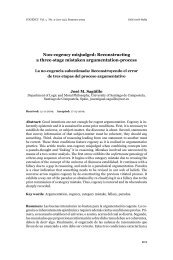Cogency v2 n2
Cogency v2 n2
Cogency v2 n2
You also want an ePaper? Increase the reach of your titles
YUMPU automatically turns print PDFs into web optimized ePapers that Google loves.
“A picture held us Captive”: The later Wittgenstein... / S. W. PATTERSON<br />
Despite the fact that the argument here is not a deductive argument, the<br />
pattern-completion task involved here will proceed in much the same way<br />
and, it is reasonable to think, with a similar margin of success. We could<br />
perhaps attempt a similar move with various argument schemes, such as<br />
appeal to authority or argument from sign. 2 It is perhaps the fact that they<br />
provide us with a familiar sort of pattern-completion task that makes us<br />
want to think of them as schemes at all. Like Wittgenstein’s puzzle pieces,<br />
there is a way the reasons fit together that allows us to place the “final piece”,<br />
the conclusion, such that it “fits” too.<br />
The important point for our purposes here is that Wittgenstein, in the<br />
quote above, is denying that this happens with the resolution of the elements<br />
of a picture into to something recognizable, like a face. The phenomenological<br />
aspect of recognition–which we also have when we fit the puzzle<br />
piece into its space, or see that we can do so from its shape and the shape of<br />
the gap in the nearly-completed puzzle–is present, but unlike the case with<br />
the puzzle, the recognition of the picture has, in his view, no grounding in<br />
reason. But then how does this recognition work? As with the understanding<br />
of musical themes, Wittgenstein’s speculation is that the understanding<br />
of a picture works linguistically: “...in the same way I may say “Now I understand<br />
the expression of this face”, and what happened when the understanding<br />
came was that I found the word which seemed to sum it up.”<br />
(Wittgenstein 1960: 167) This statement is fascinating for a number of reasons,<br />
not the least of which is the reversal of roles it envisions in comparison<br />
to the doctrine of the Tractatus. It’s wider significance notwithstanding,<br />
for purposes of this article the chief interest of this statement is that<br />
makes the understanding of pictures dependent upon associating them with<br />
words. To understand a picture, then, is to be able to translate it out of the<br />
realm of image and into the realm of the verbal, into language. While he<br />
may indeed depart from the picture theory of meaning, at no point does<br />
Wittgenstein abandon the thesis, first advanced in the Tractatus, that thinking<br />
happens in the medium of language. It is plausible that his desire to<br />
preserve this thesis in the face of the challenges presented by the intentional<br />
vocabulary (the vocabulary of wishing that, hoping that, expecting<br />
2<br />
A thorough, if possibly not exhaustive, accounting of a great many of these schemes<br />
can be found in Walton, Reed, and Macagno (2008).<br />
109








